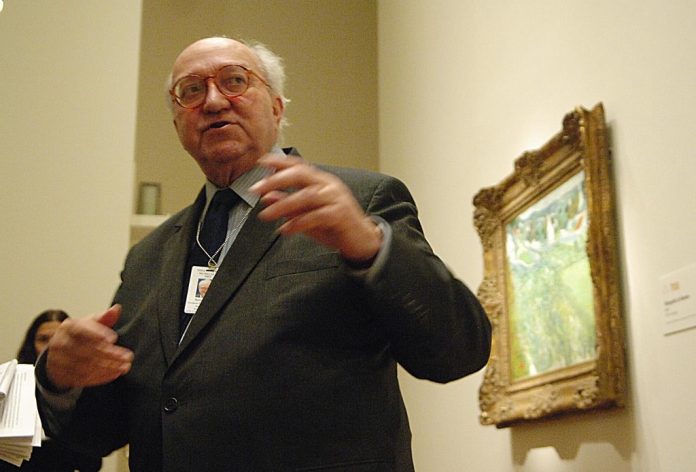Senior curator Joseph Rishel discusses paintings in the exhibit, including Van Gogh’s 1890 painting Almond Blossom. JENNY SWIGODA / TIMES PHOTO
— Artist Vincent van Gogh certainly had his share of conflicts with his mind. The great outdoors provided the troubled painter with a colorful outlet for some of his most distinctive works.
When the complexity of life over-burdened Vincent van Gogh and eroded his psyche to the point of self-destruction, the artist sought refuge in the minutiae of nature.
When repeated bouts of intense anxiety, depression and rage forced him to take up residence in Saint-Paul Asylum in Saint-Rémy, France, Van Gogh rendered his own therapy. He examined the irises, dandelions, wheat fields, cypress trees and blades of grass in the asylum gardens and surrounding countryside.
He then painted them, creating dozens of images as distinctive in their distorted perspective, rugged textures, irregular patterns and vibrant colors as they would be pivotal in the transition of modern art from the 19th century into the 20th.
Many of those Saint-Rémy compositions are among more than 40 of the artist’s landscapes and still-lifes included in the Philadelphia Museum of Art’s Van Gogh Up Close exhibition, which opened last month and will remain on view through May 6.
Museum officials expect it to become one of the most-attended events in the venue’s recent history. Some 200,000 visitors saw the museum’s first Van Gogh exhibition in 1970. Thirty years later, more than 300,000 attended Van Gogh: Face to Face, attesting to the Dutchman’s enduring power to captivate audiences more than a century after his death.
“You just see this big guy a little bit bigger because of this show,” said Joseph J. Rishel, co-curator for the exhibition and the museum’s senior curator of European painting before 1900.
Rishel collaborated with the museum’s associate curator of European painting before 1900, Jennifer Thompson; along with Anabelle Kienle of the National Gallery of Canada in Ottawa and Cornelia Homburg, an independent art historian who edited the 288-page exhibition catalog.
Philadelphia is the only United States venue. The exhibition will open in Ottawa this summer, then close for good. According to Timothy Rub, director and CEO of the Philadelphia Museum of Art, it took the organizing institutions five years to plan the exhibition, which includes works borrowed from museums and private collectors in the U.S., Europe and the Far East.
The compilation covers the final four years of the artist’s tumultuous life, which ended at age 37 with a fatal and likely self-inflicted gunshot wound. The examples date as early as 1886, when Van Gogh arrived in Paris and, with contemporary avant-garde impressionists as an influence, he began expanding his palette with bright, explosive colors and “modernizing his brush strokes,” Rishel said.
“It’s all created within a very short span of time, 1886 and ’87. It’s all kind of simultaneous,” Rishel said. “You see him experiment with color bursting at the seams.”
It was during this time that the artist produced his iconic Sunflowers series, along with other flower arrangements such as Fritillaries in a Copper Vase. Yet, he also took his focus outdoors, contrasting the close-ups with distant, yet equally detailed and colorful landscapes.
Yet, despite his artistic revelations, Van Gogh became equally defined by his personal struggles. Conflicts with his younger brother and de facto caretaker, Theodorus, along with poor health led Vincent in early 1888 to the French countryside, where he took up residence in the town of Arles and hoped to found an artists’ colony.
Although he remained prolific as ever and his work garnered the increasing attentions of his more-established contemporaries, notably Frenchman Paul Gauguin, the colony never materialized. Gauguin stayed with Van Gogh for a time late in 1888 until the latter sliced off a portion of his left ear with a razor blade in a fit of anxiety over their friendship.
The following spring, Van Gogh admitted himself into the asylum at nearby Saint-Rémy. There, he painted irises, dandelions and gardens with even greater vibrancy and detail.
“There is no horizon line. The focus is entirely on the (subject). It’s something that at the time no other artist would have done,” Kienle said.
Van Gogh drew upon his longstanding appreciation for Japanese woodcut print-makers and their sublimely focused and philosophical treatment of the natural world.
“They really had it all down,” Kienle said. “They really knew how to represent nature. It’s a ‘single blade of grass.’ That’s what really draws attention.”
Rishel noted that this method would’ve allowed Van Gogh to block out disruptive forces in his work and his emotional well-being.
“Focus allows him to reset his boundaries. It’s like tuning into one channel,” Rishel said.
However, this mentality presented a double-edged sword. It also would’ve escalated the artist’s introspection and isolation.
“It’s like tightening the lid on the bottle,” Rishel said.
“In the last years, he’s tremendously productive. You’re getting this great complex genius at work here.”
Van Gogh left the asylum in May 1890 and returned to Paris, living in the nearby community of Auvers to be near his brother and physician.
He died two months later, but even in his final weeks worked at an alarming rate, producing dozens of paintings, including many on wide “double square” canvases, including Undergrowth with Two Figures, which Kienle considers her favorite of the exhibition. ••
For information about Van Gogh Up Close, visit www.philamuseum.org or call 215–763–8100.





